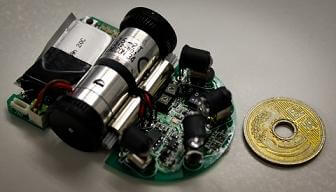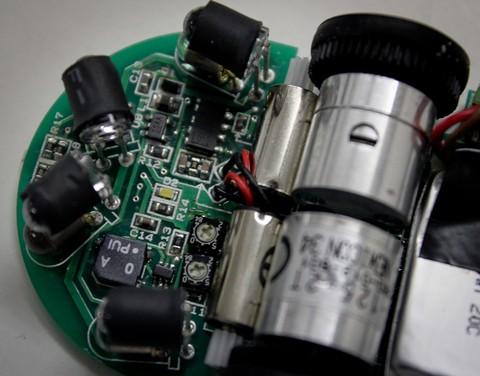World’s Fastest Miniature Robot Mice Blaze Thru Mazes (video)

Share
Every year, people from all over the world compete see who can build the fastest mouse. Mouse robot that is. These Micromouse competitions have miniature wheeled robots searching through mazes, finding the best path to their goal, and then racing to victory at speeds that may be hard to follow. The 31st Annual All Japan Micromouse Competition is set for November 20th, and already there's a fore-runner that is catching a lot of attention. In the recent regional finals in Chubu, a builder named Kato displayed one of the fastest robots we've ever seen, especially in this size. Called Egg-Torte, the half-sized micromouse whips through a complex maze in the video below. Did it win the regional? Oh yes. And it might be the favorite to take the crown at the nationals in a few weeks. Bots like this one are a testament to the innovations generated by robotic competitions all over the world.
When we covered last year's All Japan Micromouse Competition, we mentioned that the fastest robot actually didn't win, because it had a problem with the overhead lighting. Guess who made that mouse bot? That's right, Kato-san. This guy is impressive, not only did he have a great full sized (< 25 x 25 cm) micromouse last year, his current half sized version (< 12.5 x 12.5 cm) is tearing through the competition. Check out Egg Torte's fastest run for Chubu in the video below.
The micromouse competition really isn't measuring how fast a robot solves a maze, just how fast it races through it. Each mouse is given a few minutes to walk the maze and find a solution. It then has several tries to reach its best time. Often there are false starts, collisions, or other setbacks, so the multiple trials is a big part of the comeptition. Here's the full video for Egg Torte to show what I mean:
While it only came in second place at the Chubu competition, Kato's super fast full sized mouse bot from last year, Tetra, is still doing pretty well. Here's Tetra's entire attempt for the Chubu maze. His best run starts at 3:15.
Be Part of the Future
Sign up to receive top stories about groundbreaking technologies and visionary thinkers from SingularityHub.


Lem Fugitt over at Robots Dreams was able to get some amazing access to Egg Torte after its Chubu victory. From his pictures we can see how insanely well planned out the little robot really is. Each element on the printed circuit board isn't merely chosen for its electronic properties, but for its weight, aerodynamics, and center of mass as well. And the robot had to accommodate motors and sensors in addition to its controls. This is a very well crafted piece of machinery, it's no wonder that Kato is one of the more respected (feared?) competitors in Micromouse.
Say you don't care about robotic mice in Japan, why should you be impressed with Micromouse? For more than three decades it has gathered the attention of amateur and professional engineers who have come up with increasingly impressive robots. Innovation, imitation, and precision have been fostered and amplified by the community. What if the competition wasn't to build the fastest robot mouse, but to build the smallest robot that could support the most weight. Or identify the most red marbles on a table. Or whatever. Chances are that in a few years you would have increasingly impressive robots that could perform that task as well. The 'gaming' of robotic development is an amazing tool for harnessing broad based robot enthusiasm into meaningful outputs.
I'm not saying that robotic competitions are the best source for innovation in robotics. Clearly research groups are going to be at the forefront of most developments. However, there's still a place for challenges that are task orientated like Micromouse to make contributions. At RoboCup, we've seen growing interest in the rescue-robot competition, wherein bots attempt to save the lives of models of humans. Somewhere in the vast sea of weekend enthusiasts is a force that could be channeled to help further robotics as a whole.
How about we start the Micronurse competition. Who can build the fastest robot capable of taking care of an elderly person?
I'm looking at you here, Kato-san.
[image credits: Robots Dreams]
[video credits: RoboLabN]
[source: Robots Dreams]
Related Articles

These Robots Are the Size of Single Cells and Cost Just a Penny Apiece

In Wild Experiment, Surgeon Uses Robot to Remove Blood Clot in Brain 4,000 Miles Away

A Squishy New Robotic ‘Eye’ Automatically Focuses Like Our Own
What we’re reading

